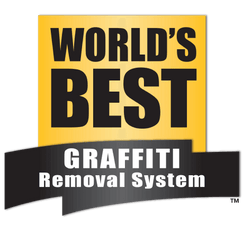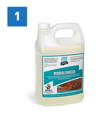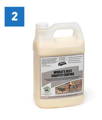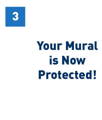We have proudly partnered with SPARC (Social and Public Art Resource Center) based in Venice, CA in the development of MuralShield for the long-term protection and conservation of fine art acrylic and aerosol murals.
SPARC has been responsible for preserving and maintaining many large and historically significant murals, providing guidance to artists, cities, and public planners since 1976.
MuralShield™ is a conservation-grade coating that works as a consolidating protective barrier, strengthening paint binders and adhesion. It offers protection against environmental damage caused by weather, UV sunlight, cleaning chemicals, pollutants, and water damage.
For graffiti protection, we apply World's Best Graffiti Coating over MuralShield, allowing for the non-damaging removal of graffiti vandalism.
This method of using both coatings together is designed to comply with conservation standards to preserve and protect public art vulnerable to vandalism and environmental wear.
The final outcome will be a highly maintainable, durable, vibrant mural.
MuralShield will build up to a gloss finish. Subsequently, the application of 2-3 coats of World's Best graffiti Coating will create a beautiful satin finish.
MuralShield is compatible with artist-grade acrylic paints, fine art aerosols, collage-based, or digitally printed murals. Compatible substrates include building structures such as uncoated concrete, wood, signage-grade panels, most exterior insulated finishing systems (EIFS) and stuccos, CMU block walls, brick walls (depending on the brick condition), painted, and coated surfaces. MuralShield can also be used to prepare concrete, CMU, stucco, painted, or unpainted walls for painting. Use MuralShield only after the wall is cleaned and thoroughly dry.
How To Apply MuralShield & World's Best Graffiti Coating
MuralShield™ is generally applied upon completion of a new work or restoration of an existing mural.
World's Best Graffiti Coating is a 'sacrificial coating' and must be reapplied every time a repair is done. This allows you to clean the mural safely using our removal products as well as providing access to the original artwork so that changes or touch-ups can be made as needed.
MuralShield™ is a solvent based product and is best sprayed rather than brushed or rolled. You can use a conventional airless sprayer, HVLP ( High Volume Low pressure) spray gun, or acetone rated pump up sprayer. We can supply the Sprayers Plus© Acetone Pro Compression Sprayer if needed. These are convenient and easy to use especially in areas where you don't have access to power.
For murals that contain solvent based spray paints and even on freshly painted acrylics it is always best to lightly mist coat MuralShield first and then build up at least 2 subsequent coats. This helps seal the mural and protect against paint runs. If using a handheld sprayer make sure you are pumping it up enough and adequately atomizing the product before commencing application.
Always test first in inconspicuous areas before attempting full scale application.

Protect and Restore

Our Coating Technology
See application of MuralShield greatly enhancing color on this older mural ("to Protect & Servce" by Nina Olabisi) Video Courtesy of SPARC.
Graffiti Removal from Mural Protected with MuralShield and World's Best Graffiti Coating. Courtesy of Mural Rescue Portland.
Safety Precautions When Applying MuralShield
MuralShield is flammable: Do not apply MuralShield near any potential source of ignition. Keep away from heat and open flame. Use only outdoors or in well-ventilated areas using a facemask or respirator. Avoid applying in populated areas.
Personal Protection: Wear gloves and protective goggles to avoid skin and eye contact. Utilize either work clothes or a disposable protective suit, to avoid garment damage or accidental spillage.
Use adequate solvent-rated masks or respirator. We recommend solvent or paint stripping rated masks with a cartridge based re-breather.
UHill Walls case studY
UHILL Walls, Durham North Carolina is an amazing public art project that features over 40,000 square ...
tIPS FOR APPLICATION
Muralshield is best sprayed using HVLP, airless or a pump up acetone rated sprayer.
When using the Acetone Pro Compression Sprayer remove the small stainless filter in the tip in as it is not needed and has a tendency to block.
When you finish spraying, clean first with acetone and pump it through the wand. Then clean with water and pump plenty of water through the wand. You can do this by pressurizing the tank with water and locking the trigger in the 'on' position and letting the water spray out for a few minutes.
You can then use this sprayer to apply World's Best Graffiti Coating and use this same cleaning technique when you are finished.
application PRECAUTIONS
Before commencing any large scale coating application, be sure to test thoroughly on an inconspicuous area to determine finish and compatibility with your materials.
Please be aware the use of solvent based sharpies for outlining your mural may bleed through paint after application of MuralShield. We do not recommend using sharpies for this reason.
When applying Muralshield, we find it is best to mist coat the first application in order to seal the mural, let it dry for at least 30 min and then begin to build up two subsequent coats. This helps avoid any runs or bleeding on vulnerable paint layers
When applying Muralshield it's important that you are sufficiently atomizing the product when spraying. Some cheaper handheld sprayers may not hold up well and will subsequently cause drips and runs in your mural during application. Please try to avoid this from happening by testing your equipment first!
Mural protection calculator
The calculations include enough product to apply the recommended 2 coats.
The total area is equal to the width x height of your surface.
hOW TO REMOVE GRAFFITI FROM A MURAL
When it comes to maintaining the beauty of your mural while effectively removing graffiti, it's essential to use the right products and techniques. This guide provides step-by-step instructions for removing graffiti from murals protected by MuralShield™ and World's Best Graffiti Coating and ensuring your artwork remains vibrant.
Small Scale Graffiti "Tag" Removal Jobs
Step 1: Application of Graffiti Remover
Use Sensitive Surface Graffiti Remover or Heritage Graffiti Remover with a solvent-rated brush. Gently agitate the graffiti with your brush as you apply the product to ensure thorough coverage.
Step 2: Wipe Away the Graffiti
After allowing the remover to work, wipe away the dissolved graffiti using a damp cloth. This will help prevent any residual marks from remaining on the mural.
Step 3: Rinse and Protect
Once you are satisfied with the results, thoroughly rinse the affected area with clean water. Allow the surface to dry completely before reapplying two to three coats of World's Best Graffiti Coating using a spray, roller, or brush. This will provide ongoing protection against future graffiti.
Adam, Director of North American Operations, Demonstrates How to Remove Graffiti from a Protected Mural
Large Scale Graffiti Removal Jobs
If you're dealing with extensive graffiti, such as "bombs," heavy tagging, filled-in bubble writing, or murals that have been buffed or painted over, follow these steps for optimal results.
Step 1: Section Work
Divide the mural into manageable sections of 5-10 sq. ft. Apply Heritage Graffiti Remover using a pump-up sprayer, and agitate with a nylon brush or broom for effective penetration.
Step 2: Rinse with Pressure Washer
As the graffiti begins to dissolve, rinse the area with a pressure washer using a 25-degree tip. Maintain a distance of 6” - 12” from the mural surface to protect the acrylic paint layer while ensuring a thorough clean.
Step 3: Spot Clean Remaining Graffiti
For any residual graffiti, spot clean using Heritage Graffiti Remover or Sensitive Surface Graffiti Remover with a nylon bristle brush to effectively eliminate stubborn marks.
Step 4: Final Rinse
After all graffiti is removed, rinse the entire mural thoroughly with clean water. Wait 15-30 minutes for the surface to dry completely before proceeding.
Step 5: Reapply Protective Coating
Apply two coats of World's Best Graffiti Coating using a spray, roller, or brush. This step is crucial for maintaining the protective layer and enhancing the longevity of your mural.
Javi removes large graffiti tag from Risk Rock mural.
GOLDEN TIPs
Removing graffiti from murals painted with acrylic-type paints requires a careful approach to preserve the artwork. Follow these steps for effective graffiti removal using Sensitive Surface Graffiti Remover (SSGR):
Conduct a Test Patch
Always start by testing a small, inconspicuous area of the mural to determine if SSGR will successfully remove the graffiti without damaging the paint. This initial test is crucial for assessing the compatibility of the remover with your specific mural.
Apply the Graffiti Remover
Once you've confirmed that SSGR is safe for your mural, brush it on and gently agitate the solution with a soft brush. Work in small sections at a time to ensure thorough coverage and effective dissolution of the graffiti.
Remove Dissolved Graffiti
After allowing the remover to penetrate the graffiti, wipe off the dissolved residue with a damp cloth. Alternatively, you can rinse the area carefully using a hand sprayer filled with clean water, followed by a damp cloth for an extra clean finish.
Act Quickly for Best Results
The sooner you address the graffiti, the better your chances of successful removal. If possible, aim to clean the graffiti within 72 hours of its occurrence. Timely action significantly increases the likelihood of restoring your mural to its original condition.
Expert Advice
Click on any of the icons below for more how-to's and advice












